“It’s like ‘what if Mad Max: Fury Road and The Hurt Locker took place in the Wizard of Oz?’ ” we talk to David Pepose about The O.Z. now funding on Kickstarter
As the world starts to recover from the chaos caused by the COVID-19 pandemic, we’ve seen businesses and industries reopen again. The same applies to comics as publishers resume their ongoing series and new titles are finally released. This also means that independent creators can return to the business of creating their own projects. One such creator is David Pepose, creator of popular comic Spencer and Locke and Going to the Chapel through Action Lab Entertainment, as kicks off the kickstarter for his new project, The O.Z this month. A genre mixing reimagining of the world of the Wizard of Oz, we caught up with David to find out more!
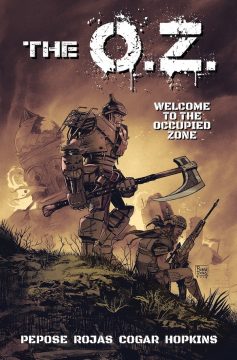 Hi David, thank you for taking the time to talk with us. How are you? Are you well? Staying safe during these chaotic times we’re all seeing?
Hi David, thank you for taking the time to talk with us. How are you? Are you well? Staying safe during these chaotic times we’re all seeing?
David Pepose: Thanks for taking the time to chat! I’ve been doing as well as anyone can hope for during this point of history — I’m just grateful that I’ve been staying healthy, and that I’ve gotten used to working from home as a freelancer these last few years.
So, what is Project Saffron or, to give it its proper name, The O.Z.?
DP: The O.Z. is like what if Mad Max: Fury Road and The Hurt Locker took place in the Wizard of Oz. It’s a story that reimagines Dorothy Gale’s killing of the Wicked Witch of the West as something akin to a botched regime change — and when Dorothy returned home to Kansas, she inadvertently left Oz in the throes of a power vacuum that would lead to years of civil war.
The O.Z. picks up a generation later, following Dorothy’s granddaughter and namesake, a disillusioned Iraq war veteran — but when this new Dorothy is swept up by a tornado, she’ll discover her grandmother’s tall tales weren’t as rose-colored as she believed. Still grappling with her own trauma from her time overseas, Dorothy’s going to have to navigate her past — and her grandmother’s former friends — if she ever hopes to bring peace to the Occupied Zone… or as the locals call it, The O.Z.
Well, that’s me very much intrigued. So, Where did the idea come from?
DP: I’ve always been a fan of genre mashups, and I started work on The O.Z. shortly after the first volume of Spencer & Locke came out, when I finally saw that people liked it and decided not to run me out of the comics industry altogether. (Laughs)
So I had been thinking I wanted to do something different than just crime books — and with me working on Spencer & Locke 2, with our villainous riff on Beetle Bailey, I had been thinking a lot about doing a war book with a twist. When I thought about The Wizard of Oz, the light bulb went off — that word “Oz” is so short but so iconic, and I realized those could be initials rather than a full word. “O.Z.” suddenly turned into “Occupied Zone,” and the image immediately clicked into place… I think I wound up writing the outline in something like two weeks.
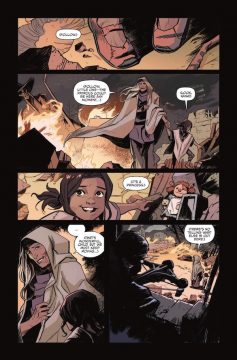 How does this relate to L. Frank Baum original classic? Is it your own interpretation or do you consider a sort of continuation to those stories?
How does this relate to L. Frank Baum original classic? Is it your own interpretation or do you consider a sort of continuation to those stories?
DP: A little of column A, a little of column B — it’s definitely a continuation of L. Frank Baum’s original Wizard of Oz novel, but it veers away from the numerous Oz sequels as sort of Ruben and I’s own specific interpretation. We do cherry-pick a little from some of the other Oz books with the settings and side characters, but as the popular consciousness stems from the Judy Garland film, I wanted to make sure we leaned on the side of accessibility over the deeper cuts.
That said, we did dig deep into Oz mythology for the various locations we use for the series, because I think the sweeping sense of scale really enhances the stakes of The O.Z. The Deadly Desert, the mountains of Ix, the Emerald City — each of these places have their unique vibe to them, and make The O.Z. feel like a much bigger adventure. And because I couldn’t resist one character from the expanded mythos — we do have Jack Pumpkinhead in the mix as well, for reasons that will become more apparent in our second and third issues…
So, who are the main characters? Will the entire cast of Wizard of Oz make an appearance?
DP: Our main character is named Dorothy Gale, and she’s the granddaughter of the original Dorothy Gale who killed the Wicked Witch in the original Wizard of Oz. Unlike her innocent grandmother, this new Dorothy has seen things during her time in Iraq and Afghanistan, and is going to be grappling with her scars throughout the book.
But she’s also the engine driving The O.Z. as a story — because Dorothy has that military training and that military way of thinking, she’s going to try to solve the problems of The O.Z. the way a soldier might. She doesn’t just see a world of magic — she sees weapons she can use to defend herself and any bystanders around her. And that intersection between fantasy and military fiction creates some of my favorite moments of The O.Z., because you’re going to quickly discover that this place is dangerous… the land of Oz has teeth.
Yet this wouldn’t be a riff on the Wizard of Oz without those iconic characters that helped the original Dorothy on her journey. But this series allows me to add new wrinkles to these characters, as well as to take their iconic characteristics to their logical extreme — we’ve got the Tin Soldier, who’s been destroyed and rebuilt so many times that’s becoming this towering steampunk war machine. He’s the guy who wanted a heart — but what happens to that heart if you’ve watched your friends fight and die for a generation?
 Or the Scarecrow, who is perhaps the most complicated figure in the story — he’s realizing that even the smartest man in Oz might not be able to close the gap in terms of bringing peace to Oz. The Cowardly Lion also has a very cool arc, and one that I think our new Dorothy can really relate to — the idea of courage is one thing when you’re just fighting for yourself, but what happens when you’re in a leadership role, and have to fight for a whole nation? As we’ll see in our second issue, Dorothy and the Lion will have a lot in common when it comes to the idea of legacy… but I don’t want to spoil too much, too early.
Or the Scarecrow, who is perhaps the most complicated figure in the story — he’s realizing that even the smartest man in Oz might not be able to close the gap in terms of bringing peace to Oz. The Cowardly Lion also has a very cool arc, and one that I think our new Dorothy can really relate to — the idea of courage is one thing when you’re just fighting for yourself, but what happens when you’re in a leadership role, and have to fight for a whole nation? As we’ll see in our second issue, Dorothy and the Lion will have a lot in common when it comes to the idea of legacy… but I don’t want to spoil too much, too early.
And we have a few other supporting characters here and there, as well — when you meet the Wizard of Oz, you’re going to fall in love… if there are any fan-favorite characters, I have the feeling it might be this one…
How big is the series planned to be? Is this a one shot, are you planning some major ongoing series, or something in between?
DP: The O.Z.’s Kickstarter will be the first of three double-sized issues clocking in at 44 pages each, and we’ll be running two more campaigns as Ruben, Whitney and DC complete each subsequent section. Not only has our team already finished the first issue, but I’ve written the entire series already, so we have a set beginning, middle and end.
But that said, if the demand is there, I’ve loved writing Dorothy and company, and I know how this series can expand beyond our initial standalone arc. I always try to have some ideas in my back pocket, and write modularly in that vein. Given that war can hit in waves, there can always be another battle around the corner for The O.Z….
Tell me about your co-creators? How did you find them? What drew you to them as collaborators on this project?
DP: Ruben Rojas was the first person I connected with for The O.Z., as I saw him responding to a call for artists on Twitter. I was flabbergasted nobody had scooped him up, so I reached out immediately. I pitched him on three different stories — my then-unacquired sci-fi heist book Grand Theft Astro, The O.Z., and a third book that’s still in development — and he immediately gravitated towards The O.Z.
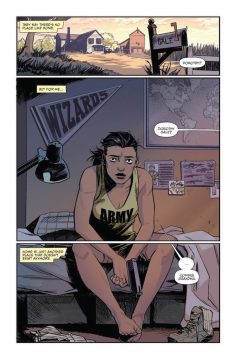 And thank goodness — Ruben isn’t just a gifted draftsman, but he’s an incredible designer in his own right, and he’s added so much depth to The O.Z. both in terms of settings and the characters. As soon as I saw his take on the Tin Soldier, I made Ruben a promise — come Hell or high water, I was going to get this book made for him.
And thank goodness — Ruben isn’t just a gifted draftsman, but he’s an incredible designer in his own right, and he’s added so much depth to The O.Z. both in terms of settings and the characters. As soon as I saw his take on the Tin Soldier, I made Ruben a promise — come Hell or high water, I was going to get this book made for him.
Whitney Cogar and DC Hopkins were both recommendations from my pal Michael Moccio, an alum of BOOM! Studios who’s now at Scholastic and Mad Cave. Mike raved about both DC and Whitney from his time at BOOM!, and when I met DC at Denver Comic Con a year or so back, we both hit it off, so I knew I wanted to work with him on something. He’s just so gracious and laid-back, which is a great counterpoint to my general level of anxiety. (Laughs) But DC and I talked a lot about how we wanted the lettering to interact with the art, and so he’s just this amazing team player who is very patient when I decide to cut half a balloon for space.
Whitney, meanwhile, is our secret weapon — she’s the colorist of the Eisner Award-winning Giant Days, and she just takes Ruben’s superlative artwork and elevates them to the next level. Whitney and I talked a lot about Star Wars when she started work on The O.Z. — just the idea of giving every setting its own unique palette and temperature, the same way that George Lucas and company did with disparate planets like Hoth, Endor and Tatooine. The result is that the land of Oz feels like a living, breathing world with so many different locales, and Whitney has just been such a champion at giving each scene its own unique energy. As someone who’s usually very demanding of colorists, Whitney kills it with very little direction from me.
Without a doubt, this title was created during the global pandemic and lockdown. Was the collaborative process with your colleagues difficult as a result than on previous works?
DP: Yes and no — I’ve actually been working on this book in some capacity since the original Spencer & Locke came out, so the vast majority of development was already locked and loaded well before the pandemic. I’m used to working with my colleagues remotely — we actually had most of this 44-page issue done before anything was locked down — but the pandemic gave me time to hunker down and wrap up scripting the entire rest of the series.
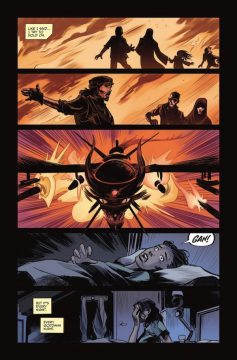 Now, your prior two series were published by Action Lab Entertainment. Given your connection to them, and the success you achieved on those past projects, why move to kickstarter for O.Z.?
Now, your prior two series were published by Action Lab Entertainment. Given your connection to them, and the success you achieved on those past projects, why move to kickstarter for O.Z.?
DP: Honestly, I’ve been looking at Kickstarter for a long time, just to diversify my readership base and to pivot more towards the digital sphere — I’m friends with people like White Ash’s Charlie Stickney and The Jump creator Rylend Grant, along with plenty of others who have had a lot of success on Kickstarter.
There’s a section of the comics-reading populace that only buy their books on that platform, the same way there are people who only buy their books at comics shops or only buy them on Amazon or ComiXology — and because I want to keep bringing more people to the table and building that broader consensus, Kickstarter has always been on the agenda.
But covid definitely crystallized that line of thinking for me, and made me decide to push The O.Z. as my debut Kickstarter campaign. With the temporary Diamond shutdown and many publishers staggering their release schedules through 2022, I realized I didn’t have to wait for permission anymore to create — Kickstarter is really empowering for creators, and lets us release our work on our own timeframe and on our own terms.
Do you have stretch goals planned?
DP: We do! I don’t want to spoil too much just so we focus on the initial campaign goals, but we’ve got some free giveaways to all of our backers once we hit certain benchmarks — including a smorgasbord of digital comics from a who’s who of indie creators, as well as some really fun artwork and other add-ons the higher we go. And that’s just the tip of the iceberg — if our success really goes through the roof, we might have to think of even wilder goals!
You’ve mentioned to me previously when we were arranging this talk that the cover art (which looks truly gorgeous) matches the interior. Was that a deliberate choice when planning the series?
DP: For sure — I always try to make it a point to have the artist I’m working with provide at least one cover to the series, just so they don’t feel marginalized for their own book. And as a reader, I always like to know what I’m getting myself into, so I like having the interior artist do a cover. It’s not to say I don’t love variant artists — we’ve got a trio of amazing ones, including Maan House, Rio Burton and Kenneth Wagnon — but I’ve found that my interior artists often have incredible visions for the books. Which makes sense, given how much time they spend on them!
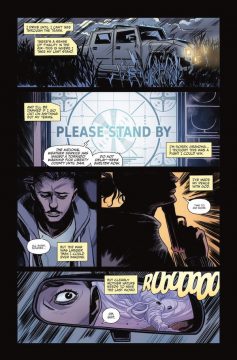 I know you’ve mentioned some influences earlier but can you name three comic books/TV shows/films/novels that three best describe O.Z.? So, “You’ll like O.Z. if you like … “
I know you’ve mentioned some influences earlier but can you name three comic books/TV shows/films/novels that three best describe O.Z.? So, “You’ll like O.Z. if you like … “
DP: That’s easy — if you liked Mad Max: Fury Road, The Old Guard, or Fables, you’re gonna LOVE what we do with The O.Z. (And it goes without saying, if you dug Spencer & Locke…)
Now, a bit more general questions. Despite being your debut series, Spencer and Locke was incredibly well received. With Going to the Chapel also being a success for you, is there pressure to ensure O.Z. continues that trend?
DP: For me, it’s always about whether I’m growing as a writer — if I’m trying something new, and whether I feel good about the work I’ve put in. For example, Spencer & Locke was like Direct Market bait, while Going to the Chapel (as a heist set at a wedding) was more like counter-programming.
Because I finish every series with a laundry list of things I want to try out with the next series, it’s always about developing new muscle groups — for example, Spencer & Locke was a pretty tight, intimate cast, so the very next series I worked on had 15 speaking roles. And because Spencer & Locke was pretty down-to-earth in terms of setting and stakes, I wanted to have a big, sweeping fantasy series… which turned into The O.Z.
It’s not to say that every book will work — I’m not going to kid myself and say I’m going to have a perfect batting average if I stick around in this field as long as I want to stick in this field — but ultimately, if I’m proud of the work, everything else is icing on the cake.
Despite starting your career as an intern at DC, Spencer and Locke was your debut title, with your career to this point being TV publicity, journalism and articles on comic book storytelling. Did you find the process of writing comics a difficult change from your past endeavours?
DP: Definitely, yes — it was extremely difficult. (Laughs) I’m just telling the truth! You know, there’s that old Upright Citizens Brigade saying: it’s easier to remember than invent. And learning how to write creatively, to come up with things whole-cloth, is such a different animal than writing journalistically!
But I think my previous career experiences have definitely helped and informed the way I do business. My time as a DC intern really made me realize all the moving parts to the comics industry, not just putting faces to the names of the writers, pencillers, inkers, letterers and production team, but departments ranging from creative services to marketing to publicity. It takes a villain to get this stuff done.
Meanwhile, writing reviews for Newsarama for as long as I did gave me just enough training… to barely get my first book over the finish line. (Laughs) But that’s the thing — you can absorb so much academic knowledge, but it’s purely academic until you do the thing. And finally, my experience working both sides of the journalism/publicity aisle was also hugely helpful in terms of teaching me how to promote my own work — which I think a lot of creatives don’t realize is critically important.
Especially if you’re a writer — you owe it to your creative team to talk them up as much as humanly possible. If you’ve done work for a publisher, ask them for a sample press release. If you haven’t worked for a publisher, ask a friend who has to show you a sample press release. Being a journalist taught me how to pound the pavement on a deadline, but it’s a skill set that every comics creator needs to know.
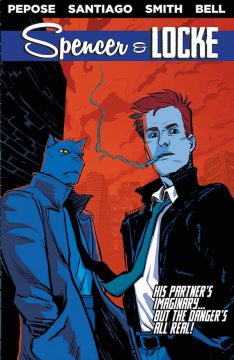 There have been theories online that Spencer and Locke are simply a grown up reinterpretation of comic strip staples Calvin and Hobbes. Assuming this is true, and given O.Z.’s concept, does using classic stories with a twist have a particular appeal to you?
There have been theories online that Spencer and Locke are simply a grown up reinterpretation of comic strip staples Calvin and Hobbes. Assuming this is true, and given O.Z.’s concept, does using classic stories with a twist have a particular appeal to you?
DP: Oh yes, I’m not even sure if we can even call that a conspiracy theory — Spencer & Locke is many things, but subtle about its inspirations is not one of them! (Laughs) But yes, definitely, I think there’s an appeal to taking childhood properties and taking a harder spin on them — it’s not for the sake of shock value, however. Shock can only get your foot in the door once — but it’s no substitute for genuine engagement. It’s easy to write a book that’s gritty Sesame Street, where Elmo cooks meth in Oscar the Grouch’s trash can or what have you — but there’s no deeper theme to justify the concept, so it becomes edgelord nonsense.
For me, I think nostalgia is like a collective memory — it’s our shared image of when the world was less complicated and more safe. Worlds like the Wizard of Oz are populated with these universal archetypes, which in turn I think are more durable and flexible and accessible to the greater reading populace — I think we know instinctively these characters will not break, and that allows them to lead us on deeper dives into heavier subject matter as a result.
That said, just like Going to the Chapel isn’t based on any particular childhood property, this is something I only want to do if I have a deliberate story in mind, something that actually justifies the amount of time (and risk!) it takes to make these things. Never say never, but I feel like right now, I want to do this a maximum of three times. We’ll see — there are a couple of other ideas I’ve had my eye on, but we’ll see if the story is right…
Well, I’ve gotta say, I hope you find the right story for that ‘Breaking Elmo’ comic ‘laughs’. So, Like many in comics, you are known for giving your projects codenamed, like this endeavour being ‘Project Saffron’. How do you come up with your project ‘codenames’? Is there some sort of connection or are they just random words?
DP: There’s always a connection, but I try to make it just a little obscure. For The O.Z., I had called it Project Saffron — thinking of saffron yellow, with the Yellow Brick Road. For me, it’s letting me have my cake and eat it, too — I get to tell the readers of my Pep Talks newsletter about what I’m working on without totally spoiling any press announcements we have.
But other times I go so obscure that it’s more of an inside joke for me — my upcoming superhero one-shot Project Juniper is titled that just because that’s a character’s name, not because it reveals the high concept. Sometimes it’s for the sake of respecting a publisher’s timeframe, but other times, it’s just remembering the value of a good press rollout — sometimes teasing an idea for a little while leads to an even bigger announcement down the pike.
Well, on the discussion of bigger announcements, do you have anything else in the pipeline that you can tell us about?
DP: I can tease a few things! I’ve got a few anthology stories coming down the pike, which hopefully we’ll be able to talk about sooner rather than later — one of them is a slice-of-life story set during the pandemic, the other one is creepy twist on my method of crime fiction, and the third one is a horrific take on a childhood icon, just to scratch a couple of itches I wouldn’t be able to do for a full-length series. I’ve also got a superhero one-shot coming from my Spencer & Locke partner-in-crime Jorge Santiago, Jr., which we’ll hopefully be able to talk about later this year.
Beyond that, I’ve got some more series in the pipeline — I’ve got a more spiritual post-apocalyptic story that will hopefully be announced in the next few months, plus work on Spencer & Locke 3 and my upcoming sci-fi heist series Grand Theft Astro, which is fully written and just working on the artwork now. Oh, and an all-ages action-adventure story that we’re starting to get artwork in on now, because when we get back to conventions, I’m tired of not being able to sell anything to younger readers! (Laughs)
So yes, a busy couple years ahead. But for the time being, it’s just promoting The O.Z.’s Kickstarter, overseeing new artwork, and finally starting work on writing a few new series!
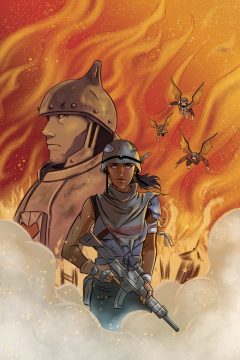 How did you get into comics?
How did you get into comics?
DP: As far as getting into reading comics, I’m a third-generation comics fan — my grandfather was a comics fan, my mother was a comics fan, and pretty much from the moment I was given a copy of Amazing Spider-Man #346, I was hooked. And then when I got Infinity War #2, my head must have exploded. All those characters knew each other?!
From then on in, I would dive back into the industry in waves — Knightfall, Death and Return of Superman, and Daredevil: The Man Without Fear in elementary school, Crimson, Spawn and Kingdom Come in middle school, Batman: Gotham Knights and JLA in junior high, up to Civil War, New X-Men, The Ultimates and Y: The Last Man in college.
It was around that time I decided my pie-in-the-sky job would be to work in comics, so I spent my entire undergraduate career applying to intern at Marvel and DC. It took me four years of calling, but DC brought me on board as an editorial intern when I graduated, where I worked on Final Crisis, Batman: RIP, Green Lantern, and more.
It was an amazing job, but it was during the recession, so from there, I wound up being referred to my mentor Troy Brownfield, who ran the reviews section at Newsarama. He and I hit it off, and I wrote reviews for the site for over a decade, until I succeeded Troy as their Reviews Editor. I recently stepped down at the site so I could focus on my comics writing, but I think my time in the trenches of comics journalism really prepared me for my writing career.
Finally, what are your favourite comics (besides your own of course)?
DP: Favorite comics… that’s a great question. Devin Grayson and Roger Robinson’s Batman: Gotham Knights has always been one of my all-time favorites, and it’s criminal they’ve only gotten one trade paperback collection as far as I’m aware. Devin’s way of weaving emotion and exploring trauma and depression has always cast a long shadow on my work, and the way that Roger has drawn what I consider to be a timelessly classic design on Batman… it’s the book that made me into the writer I am today.
And I see a direct continuation of Devin’s work with classic runs like Geoff Johns’ Green Lantern/Flash/JSA/Teen Titans or Dan Slott’s Amazing Spider-Man, both of whom I see as major influences on my own work. (For Geoff especially, if you haven’t read Justice Society of America #8, with Liberty Belle and Damage, it’s one of the best single issues I’ve ever read.)
But maybe I should give you a comic that’s actually come out in the last 15 years! (Laughs) Recently, I’ve been really digging Jed MacKay and Carlos Villa’s run on Black Cat, Al Ewing’s work on Immortal Hulk and Guardians of the Galaxy, Michael Moreci and Joshua Hixson’s The Plot… Paul Allor and Chris Evenhuis have been long-unsung heroes for their superlative work on G.I. Joe, which deserves 100 issues if there is any justice in this world. Christopher Sebela’s work on Crowded has been an inspiration for a long time. There’s Charlie Stickney and Conor Hughes’ White Ash, Bleed Them Dry over at Vault… I could go on. (Laughs)
For me, the best comics are about the intersection of high concept and genuine emotion. If there’s any common thread through my work, it’s about taking an insane premise and making people actually believe in it — there’s so much metaphor that can be mined into deep, engaging characterization, so I’ve never been into playing it subtle with the tone. Go big or go home, but no matter what, never forget the human beings in your story, and the human beings reading it. That’s been what binds all my favorite comics, and I think that’s an ethos we bring to the table for all of our fans reading The O.Z.
Thank you so much for taking the time to talk with me, David. This has been a real blast!



December 20, 2025 @ 6:55 am
„Das Casino ist mit seinen internationalen Gästen hochrelevant für den Sommertourismus rund um den Wörthersee, der eben dadurch eine ganz andere Sichtbarkeit
bekommt. „Im Regierungsprogramm ist von einer Erhöhung der Glücksspielsteuer von mehr als zehn Prozent die Rede, was rund 75 Millionen Euro ausmachen würde.
Wie berichtet hat Erwin van Lambaart, Generaldirektor
der Casinos Austria, dies am Wochenende angesichts der Steuerpläne der neuen Bundesregierung
wissen lassen. Hochsaison im Juli und August und einem wichtigen Dezember – ein klassischer
Saisonbetrieb. Auch ist es – mit einer Saison von Mai bis
Ende September bzw. Zwar ist Velden bei weitem nicht
so profitabel wie die Casinos in Wien und Bregenz.
Das Spielangebot in Velden deckt die in Österreich etablierten Tischspiele ab.
In Summe positioniert sich das Haus als zugängliche, touristisch verankerte
Spielbank im Süden Österreichs – eingebettet in ein breiteres Casino Kärnten Umfeld und mit einer Eventdichte, die über reines Glücksspiel hinausgeht.
Das Casino Velden Österreich liegt prominent an der Seepromenade von Velden am Wörthersee.
Ziel ist Orientierung statt Werbung – mit dem Anspruch, Entscheidungshilfe für verantwortungsbewusste
Besucherinnen und Besucher zu geben. Velden am Wörthersee
gilt als einer der markantesten Tourismusorte in Kärnten – und das Casino Velden ist
seit Jahrzehnten ein Fixpunkt im lokalen Nachtleben.
References:
https://online-spielhallen.de/malina-casino-login-ihr-tor-zu-einer-welt-voller-unterhaltung/
December 26, 2025 @ 2:17 pm
The Ozvin app is a great choice for players who love
online casino games. Regular players enjoy reload
bonuses, free spins, and cashback offers. If you meet those requirements,
you’re welcome to join the casino, deposit funds, and play online casino games
for real money.
Ozwin’s welcome bonus is a 200% match up to $4,000, which is split across your first two deposits.
However, you cannot win real money from playing free games.
Add in the low minimum deposits, and you’ve got a casino that’s still worth checking out.” Before deciding to play, have a look at some of our other online casino reviews.
Essentially, any Curaçao licensed casino is a trustworthy establishment. Not new to the online casino industry, Ozwin Casino has been making a name for themselves since 2020. The promotions are updated on a regular basis and it is important that the player checks the promotions and notes any changes. Each game has a theme and style to it and the player can find himself visiting ancient sites, entering worlds of fantasy and make believe, enjoying sporting events or visiting a different world in space. All the games are provided by Real Time Gaming, one of the top software companies for online and mobile gaming in the world today. The casino operates under a Curacao licence, uses SSL encryption, and relies on certified RNG tech for fair results.
References:
https://blackcoin.co/video-poker-rules-progressive-jackpot/
December 27, 2025 @ 11:42 am
Ripper Casino boasts a whopping game library of over 2,500
pokies, table games and more. We are committed to providing
a balanced and enjoyable gaming experience for everyone.
We support fast, secure, and crypto-friendly banking options.
Get special bonuses when new games are released as well as additional bonus points
when you deposit using the appropriate methods.It all starts with a sign-up bonus and a four-part welcome
package! Ripper Casino offers a wide range of deposit and withdrawal options to suit
every player – but one of our specialities is catering to all you crypto keen beans.
Minimum cryptocurrency deposits are as small as
$10 – and as little as $20 gets you a 150% bonus.
With generous welcome bonuses up to AU$7,500
and a mobile-optimized platform, you’ll never run out of exciting
options. Our curated selection of games, crafted by renowned developers, offers an unparalleled gaming experience that rivals the finest establishments worldwide.
These systems ensure that every spin, roll, or card draw is completely random and unbiased, providing an honest gaming experience for all players.
And with crypto-friendly options, you can play on, well, whatever currency you like!
Now, let’s talk bonuses – we’re talking up to A$7,500 welcome packages and daily
reloads that’ll keep your wallet happy. And don’t worry about breaking the
bank – instant cashouts and smooth mobile play mean you can get back
to the action whenever you want. Ripper Casino is serving up a wild time with its 2,500+ games, courtesy of top providers Pragmatic Play and BGaming.
Ripper Casino is an exclusive haven for discerning players, founded on a vision of luxury and sophistication. We’re stoked to have you on board and can’t wait to show off our massive library of
over 2,500 games, featuring titles like Gates of
Olympus and Wolf Gold.
References:
https://blackcoin.co/betonred-online-casino-a-bold-new-place-to-play/
December 29, 2025 @ 6:01 am
online betting with paypal winnersbet
References:
https://www.swingputt.com
December 29, 2025 @ 6:24 am
casinos online paypal
References:
https://giaovienvietnam.vn/employer/play-paypal-pokies/